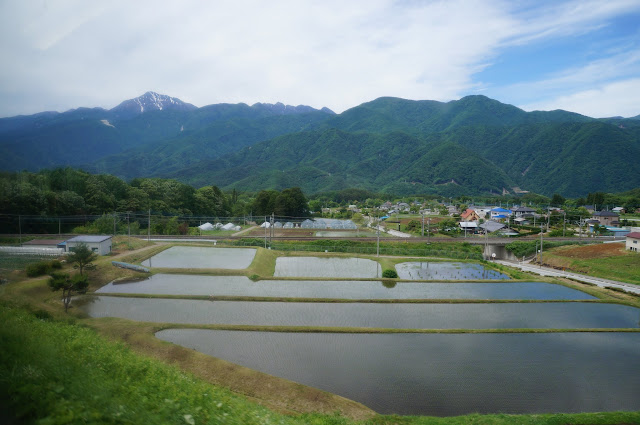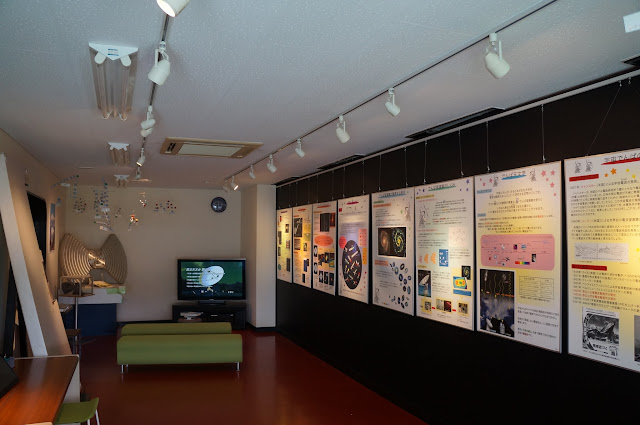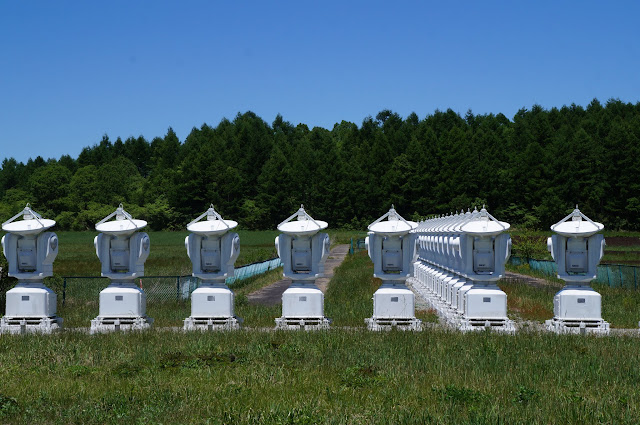"What a difference a day makes!" I thought as the Super Asuza again headed back up towards the mountains west of Tokyo. It was not yet Tachikawa, where I had hopped off yesterday, defeated by the rain, and I could already see Mount Fuji, dark grey with streaks of snow against a sky of pale white cloud and blue.
This was the railway line where I had first spotted this most famous of mountains, an active (though not currently so) volcano 3776 metres high, the highest point of Japan. I was en route to another highest in Japan; the highest railway line.
Surprisingly, for such a mountainous and railway dense country, the highest elevation of the Koumi Line is beaten by a quarter of a kilometre by Australia's Skitube and by over three and a half kilometres in the case of the world's highest railway, the line to Tibet.
It is not just its height and near perfect conical shape that makes Mount Fuji so remarkable. It stands in isolation to the surrounding landscape, separate from the mountain range that we are heading towards.
As the train climbs we leave the grey of suburbia and enter a mountainous green landscape, pretty towns clinging to ridges, rice paddies forming patchworks along the river, overlooked by rock formations atop steep slopes. It is gorgeous scenery that we sadly had to ignore on our last ride along this stretch of the Chuo Main Line dealing with Alex's motion sickness.
 |
| Love letter |
We curve around and then down into a wide valley, the city of Kofu. A lady behind me, noticing my constant photography, taps me on the shoulder and points out Mount Fuji, visible again.
At Kobuchizawa I change to the Koumi Line and a two car diesel set and we head up the forest lined track into the mountains. It is a pretty route through a rich green forest landscape. Hidden amongst the trees are many cabins, the summer homes of better off Tokyoites.
Just before Kai Koizumi station I am surprised to see a building with camel statues within and without, for only the middle of an ocean would be a less appropriate spot for such animals. I write it off as yet another example of the quirky Japanese habit of building inappropriately located attractions, but it turns out to be a museum devoted to Hirayama Ikuo, a Japanese Nihon-ga artist who painted and collected items from the Silk Road.
Japanese whimsy is also in evidence at Kiyasato, once a fashionable resort town for Tokyoites. Colourful, European and American styled buildings overlook Mount Fuji while an old steam train stands preserved at the station. Inspired by this post on Spike Japan I should like to leave the train here and explore. Perhaps I will return if I have time.
Right now I have an objective in mind. We farewell Mount Fuji at Kiyosato and continue on to the highest point on the line at 1,346 metres above sea level. As we approach Nobeyama I spot the reason for my visit, a large radio telescope dish.
I knew of Kiyosato as a stopover, but when studying the map of the area I wondered what Nobeyama might have to offer. A search revealed the presence of the Nobeyama Radio Observatory and knew I had to visit.
I used to work as the web master at the Australia Telescope National Facility, have visited its facilities at Narrabri and Parkes and studied astronomy as part of my university course. But on the Nobeyama Radio Observatory website it doesn't actually tell you if you can visit the observatory. In the absence of any information I decided to give it a go anyway.
A group of other passengers get off at Nobeyama and crowd around the front of the quirky little station building, posing for photographs. Following the access instructions on the website I begin the long walk to the observatory under warm blue skies.
I immediately fall in love with the quiet town and its surrounds. Against a mountain backdrop still touched by the remnants of the winter snows is farmland that seems mostly devoted to that most unexciting crop, lettuce, planted in long rows of plastic sheet protected soil. Tractors share the roads with small trucks while old ladies tend to gardens of colourful flowers.
As I walk down the country road small groups of young school students are walking in the opposite direction. They greet me with cheerful "Hellos!", "Konnichi-wa" and even a single "Bonjour" as they pass, then stop to giggle to each other.
A big circular building stands near the entrance of the observatory. Is this a visitors centre for the telescopes? I enter and see a small shop selling astronomical and local souvenirs. But the shop keeper points me towards the observatory gates across the car park. It seems like this may be some sort of planetarium or astronomy movie experience attraction not directly related to the observatory, and in Japanese only. Edit: It's actually called the Minakami Village Library.
Before I cross to the observatory I climb to the roof of the building where there is a lookout across the area with stunning views.
The entrance gate to the observatory welcomes visitors and the attendant hands me an English pamphlet. Unlike the tightly controlled entry into the Australian sites, visitors are free to wander around most of the observatory grounds. There is extensive information in Japanese, but English signage is almost non-existent, though the brochure is quite good and there is an English video at the visitors centre.
This is a radio astronomy facility, so it doesn't have the kind of telescopes that you look through lenses with your eyes at visible light. Instead they observe signals in the so called radio spectrum and, in the case of most of the instruments here, in wavelengths of the millimetre range and less. These signals usually come from the clouds of gas and dust that permeate through galaxies and around where stars are formed. These clouds, tenuous though they would seem to us compared with our atmosphere, block a lot of the visible light that comes from interesting phenomena like forming and dying stars, spinning pulsars, colliding galaxies and the powerful black holes at the centre of them.
However, depending on the wavelengths of the energy emitted by these objects, they may either be visible to other instruments or they may stimulate the clouds to emit their own energy, thus giving us a view of the gas clouds themselves. There is so much more to the universe than the stars and planets we see above us.
Just as the hydrogen and other molecules in the gas clouds can affect the transmission of radio signals in space, so too can our atmosphere. Millimetre signals are particularly susceptible to water vapour in the atmosphere, hence the need to position the telescopes at dry locations and high altitudes where the thiiner, colder air can hold less water vapour (remembering that water vapour is the gaseous state of water: we are much more familiar with its liquid and solid states - ice). It is for these reasons, plus the protection by the mountains from stray radio interference generated by human activities, that Nobeyama was selected.
As I walked in I was greeted by very wide railway tracks and six "dishes", each 10 metres in diameter. These were the Nobeyama Millimetre Array. A special vehicle could travel along the tracks, arranged in a T shape with a turntable at the junction. The vehicle would lift and carry a dish to a particular fixed station along the track, where it would be connected in to power and communications.
The multiple telescopes can be pointed together at the same source of radio signals in the sky and each will receive a slightly differently timed signal. By combining the signals together a higher resolution image can be obtained than by using a single telescope. The further apart the antennas are, the higher the resolution, but positioned closer together they can study larger objects, hence the need to move the individual dishes into different configurations.
Interestingly, this technique of radio interferometry was pioneered in Sydney by researchers who had worked on radar technology during the Second World War.
These six dishes were now defunct, having been used to develop some of the technology behind the massive Atacama Millimeter Telescope Array (ALMA), located at an altitude of 5,000 metres in the Chilean desert. If you consider how small a millimetre is and that the signals studied were less than that in wavelength it's possible to appreciate how fine the tolerances on the surface of these dishes must be and how sensitive the instruments developed to measure and process those signals.
Still functioning was the large 45 metre diameter dish behind the array. Whilst interferometers like the Nobeyama Millimeter Array can have a higher resolution than a single dish, the whole instrument is only as sensitive as its individual parts. With its larger surface area the big dish can collect the energy from a fainter signal than the array.
Incidentally, I once researched and wrote most of an essay assignment on single dish astronomy while on a KLM flight between Seoul and Amsterdam, typing it up on a tiny Linux PDA. It's some of the most fun I've had in the air.
Besides the 45 metre dish is a control room and, upstairs, a small display area with a video, posters, exhibits of equipment and glass windows to look at the observers at work. I noticed the Super VHS recorder standing on display.
I once shared an office at the ATNF with an astronomer, Roopesh, who worker on Very Long Baseline Interferometry, using telescopes across Australia and the world to produce higher resolution images than is possible with a single array. In those days they collected all their data on Super VHS, an improved version of the standard consumer system. Each telescope would collect their data on a video tape, which they would ship back to Sydney to "correlate", or combine into a single output by matching the time signals recorded on each tape. Anyone who remembers video tape and their audio cousins, cassettes, will remember how painful they could be to use.
Today the signals can be sent over fast networks and combined in real time, making the process so much easier.
The two astronomers in the control room had finished their work and, as I went outside, the 45 metre dish rotated to point directly upwards, in its stowage position. Most of the observing is done during winter here, when the air is dryer.
It's not just the distant stars and galaxies that are observed at Nobeyama. Further along was another T shaped array, this one consisting of 84 tiny 80 centimetre dishes. These, called a radioheliograph, are used to make high definition radio images of our own Sun. There is also a series of six antennas, each with a different sized dish, used to observe the polarisation of radio signals from the Sun at different frequencies. This can tell you about how the emitted energy is interacting with the plasma that makes up the Sun and its atmosphere.
Having completed a circuit of the observatory I sat down to eat lunch from the small o-bento I had brought with me from Shinjuku, under the gaze of the mountains and the dishes. Even if you aren't a student of astronomy the combination of beautiful natural scenery and very human technology is a thing to behold.
I now began the long trek back to the town, breathing in the not unpleasant smell of farm life, enjoying the silences of the countryside.
Thirsty, I stop for an ice cocoa (you need to say cocoa, not chocolate in Japan) at a small roadside hut selling coffee and snacks. As usual the counter was lined with quirky knick-knacks from across the world. Thinking that I did not want to miss any oncoming train I order take-away.
There was no signal for my mobile data provider and I feel lost without a timetable. I'd managed to leave one in the station just after requesting it.
It turns out that I had over 40 minutes left to wait for the next train. And there was not enough time to return to Kiyosato as well, for I had an appointment back in Tokyo. No matter, as I was sure I could convince B to visit this pretty area one day in the future.
I wander over to the park across from the train station. It housed steam train C5696, a compact locomotive that looked built for the mountains. Behind the park was a large building grandiosely described by a road sign as the History and Race Data Mansion. I think it was a museum. There were lots of posters of another C56 class locomotive hauling a train. I wasn't sure if they were advertising a tourist service or an exhibition inside, but the interior didn't look interesting when I peered in through the window, so I gave it a miss. The steam train ride would be fun, though.
The rest of the park looked rather unloved and smelled of urine. I returned across the road to "White Rabbit" which sold a variety of souvenirs and "omiyage" from the region. I purchased some apple chocolates and moshi, then continued wandering around looking for a more substantial lunch.
The building with the big Picnic sign is obviously abandoned inside, though it looks like there is some construction work going on nearby. Not much seems open, though I don't try to explore too much of the town. Adjacent to the station are a couple of tourist oriented eateries that dodn't look particularly enticing, so I stick with what I have eaten already.
Most of the other passengers at the station are heading back towards Kobuchizawa. The two trains come at once. I want to complete the line so I jump on the one headed onwards towards Komoro.
The line follows the Chikuma River and there are plenty of pretty riverside scenes, more mountains, farms and forest as we head downwards from our high point. It really is a lovely line deserving of further exploration along the way.
Whereas Mount Fuji was the dominant mountain on the way up the line now another volcano takes its place. Two and a half kilometre high Mount Asama is the most active volcano in Honshu and its slopes are barren. The mountain keeps us company all the way to my stop of Sakudaira, where the Koumi Line meets the Shinkansen.
I only have half an hour to kill, so I wander around the station complex. There's the local tourist information and souvenir centre advertising Fathers Day, but not much. A Toyoko Inn and other business hotels show this to be a transit stop.
One of the new E7 or W7 Shinkansens pulls up at the station, an attractive white, gold and blue on the outside, red and grey seats inside. I'm exhausted and just want to relax. This is a pretty comfortable train for doing it in. Having been on this train a couple of months earlier I feel no need to document the scenery outside as it flashes past.
All too soon I get out at Omiya Station, home of the as yet unvisited railway museum and race to catch the Shonan-Shinjuku Line to Ikebukuro. In the rear of the last carriage I'm treated to an amazing view of a ride along the elevated railway line as we match a Shinkansen for speed for a while and other commuter train shoot past in the opposite direction.
A change of trains at Ikebukuro and two stops later I am at the wonderfully named Takadanobaba with its Astro Boy station music. At this colourful student enclave I meet fellow blogger and expat university lecturer Cecilia aka Ponkan Chan. During a long meal at a Burmese restaurant we chat about many things Japanese and Chinese. In my bag is a special delivery of Cadbury Vegemite Chocolate, a horrific conception that I see as revenge for Japan having created sea urchin ice cream.
On returning to Shinjuku I am absolutely exhausted, but with this being my final night and with all the vibrant life on the streets I cannot bring myself to return to the hotel. Less than a week before I visited the newly opened Japanese fashion store UniQlo in Miranda, Sydney. Now I am searching for gifts from there in Shinjuku and from other clothing stores.
With 30 minutes to spare before closing time I return to the PePe building which houses my hotel and make little purchases from a variety of shops on the different floors, including my precious grapefruit Gokuri drink from the Can Do supermarket that looks like an offshoot of Jetstar.
I'm totally, utterly exhausted. I need an onsen bath, but there will be none on this trip, so I take a hot bath with bright yellow bath salts I have just bought and let the aches dissolve away with the crystals. I shall be sad to leave.
Full video from the trains along the Koumi Line is below:









































































Comments